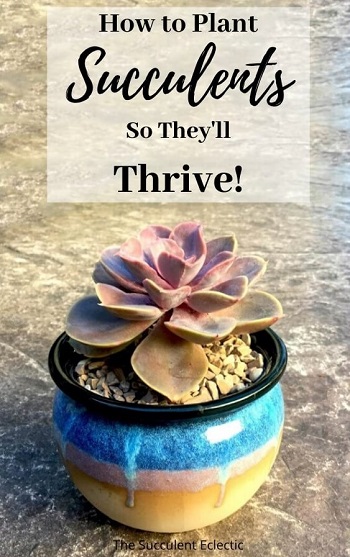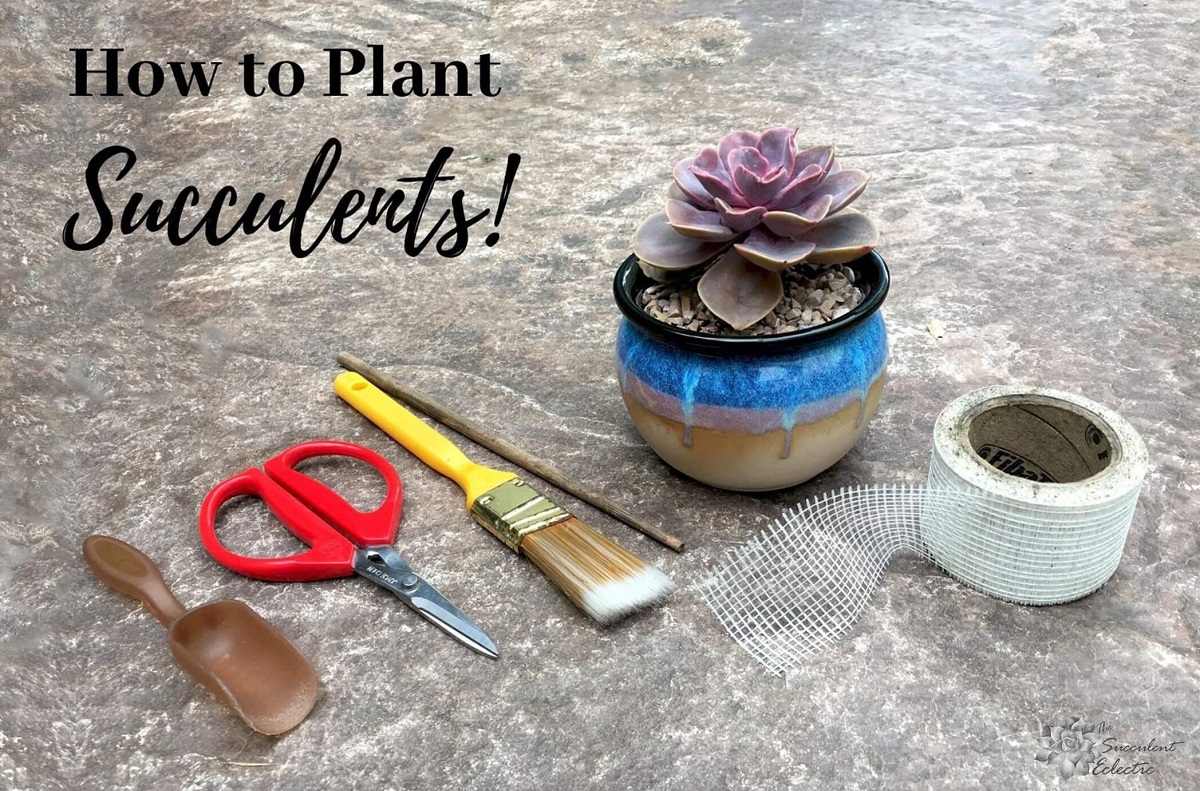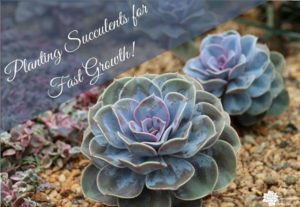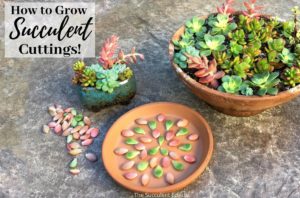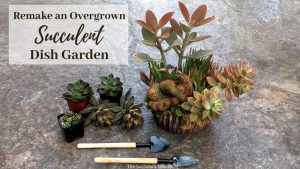Everyone always says succulents are so easy to grow, right? So why do so many people struggle to keep their plants healthy and happy? Often, they make a mistake at the very beginning, when planting the succulents, which makes it difficult to provide proper care as the plant grows. Learn how to plant succulents so they will thrive. It’s a simple process, but there are important considerations. Read on for my step-by-step guide to planting succulents, and get some tips and tricks I’ve learned along the way. I start with a single succulent in a pot and then cover several succulents together. At the end, I address succulent planting FAQs. Yes, this is basic information. But it’s also the foundation of all good succulent care.
Step-by-Step Guide to Planting Succulents
In this Post We'll Cover:
- Step-by-Step Guide to Planting Succulents
- Supplies for Planting Succulents
- Choosing a Succulent Container
- Cover Drainage Hole with Tape
- Choose Succulent Soil
- Remove Succulent’s Nursery Pot
- Plant the Succulent
- Brush Away Stray Soil from Succulent Leaves
- Adding Top Dressing to Succulent Pot
- How to Plant Succulents Several to a Pot
- Chopsticks are Handy Tools
- How to Water Newly Planted Succulents
- Succulent Planting FAQs
- How to plant succulents in pots without drainage holes?
- Can you plant succulents in rocks?
- How to plant bare root succulents?
{Please note, some links in this post may be affiliate links to sites that pay me a small commission if you click on the link and make a purchase. This commission is at absolutely no cost to you. I only recommend products and companies that I have worked with and truly love! ~Kat}
Supplies for Planting Succulents
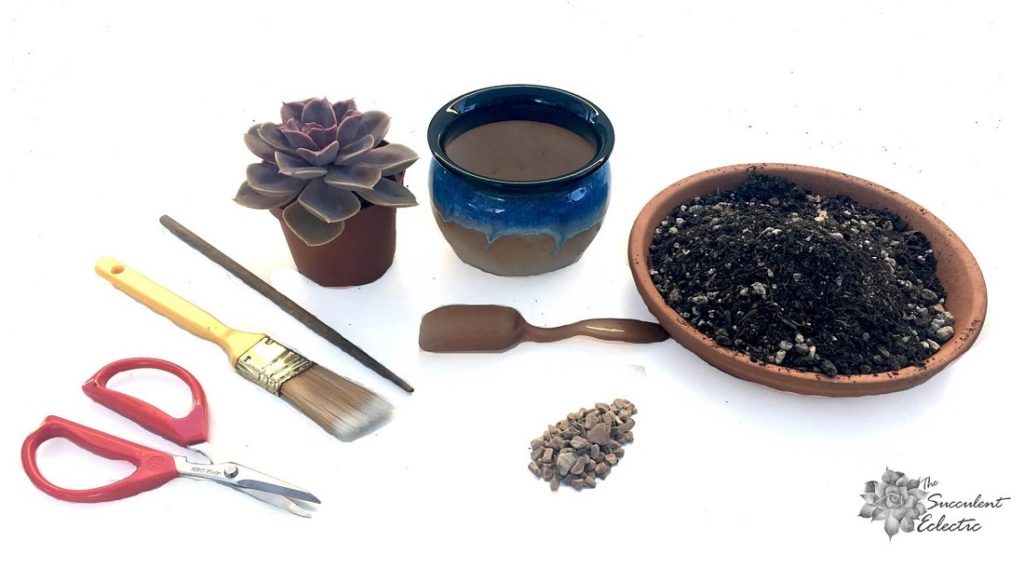
We’re going to look at how to plant succulents in a container. While you don’t truly need all of these supplies, you’ll find them useful, especially if you get bitten by the succulent bug! I use these items all the time for planting and tending my succulents:
- Small container with a drainage hole (very important!)
- Fast-draining succulent soil
- Dry-wall mesh tape
- Sharp clippers/scissors
- Soft bristle brush
- Small scoop
- Decorative pebbles
- Chopstick
- Succulents! 🙂
Choosing a Succulent Container
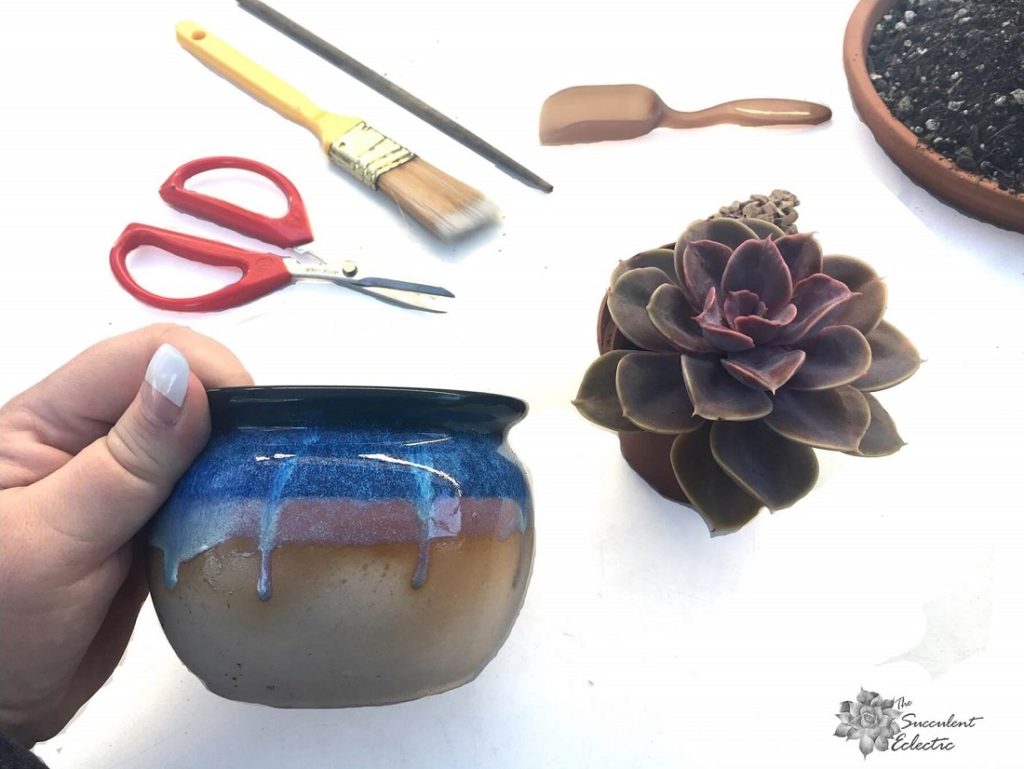
The single most important issue in succulent care is proper watering. The plants need sufficient water for life, yet too much water risks rotting the roots and killing the plants. It’s very difficult to get the watering right if you choose the wrong container. I prefer ceramic, though there are many types of containers available. The key considerations are drainage and size:
- A succulent container should have good drainage. This means a hole or holes at the bottom of the container that allows excess water to leave the container, so the soil dries quickly.
- Choose a succulent container that is just a bit bigger than the succulent plant (or plants) you will be planting. A pot that’s too large will hold lots of soil without any plant roots to take up water. The empty soil will hold excess water, preventing the soil from drying well. Check out some fun succulent pots here!
While it is possible to grow succulents without drainage — it is tricky, and I do not recommend it for beginners. Choose a small container with ample drainage. This pot is about 4.5-inches across — a perfect size to plant a 4-inch succulent like this Echeveria Perle von Nurnberg. See the mauve-colored glaze below the blue? It’s a nice accent for the mauve tones of the PVN.
Cover Drainage Hole with Tape
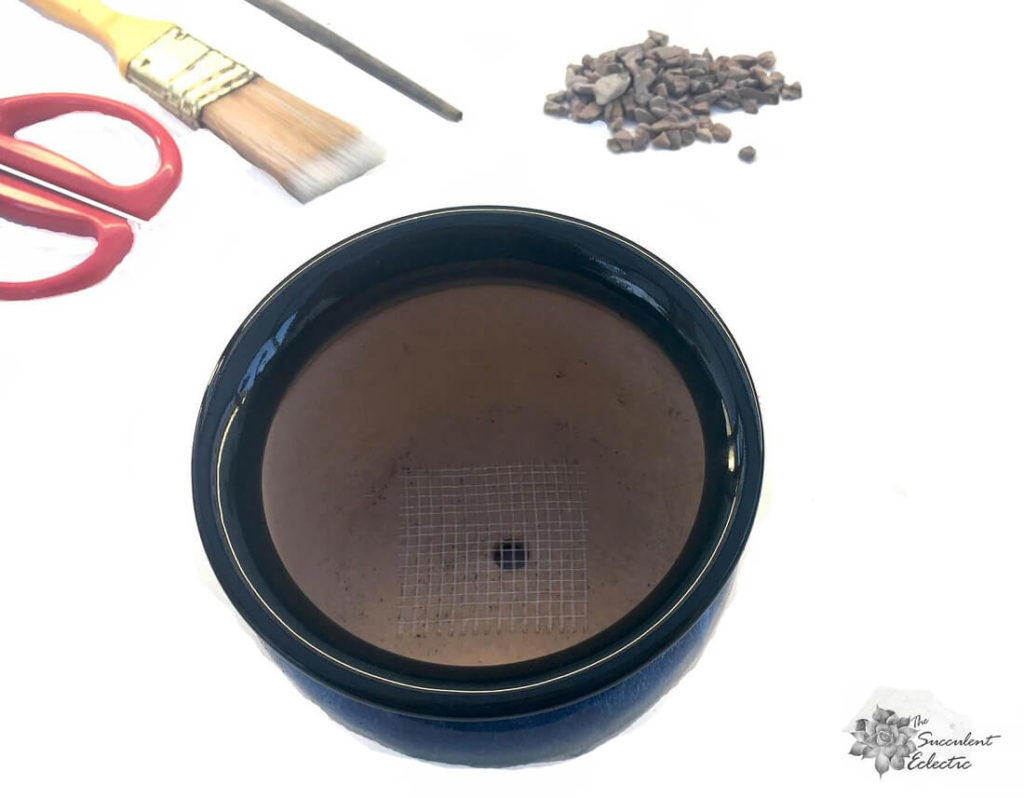
Cut an inch of the dry-wall mesh tape to cover the drainage hole. The tape is slightly sticky on one side, which holds it in place. The mesh prevents the soil from falling out of the drainage hole. You can use a broken piece of pottery, paper towel, coffee filter or a piece of screen to do the same job. One roll of tape will handle several hundred pots, and it fits neatly into my succulent kit.
Choose Succulent Soil
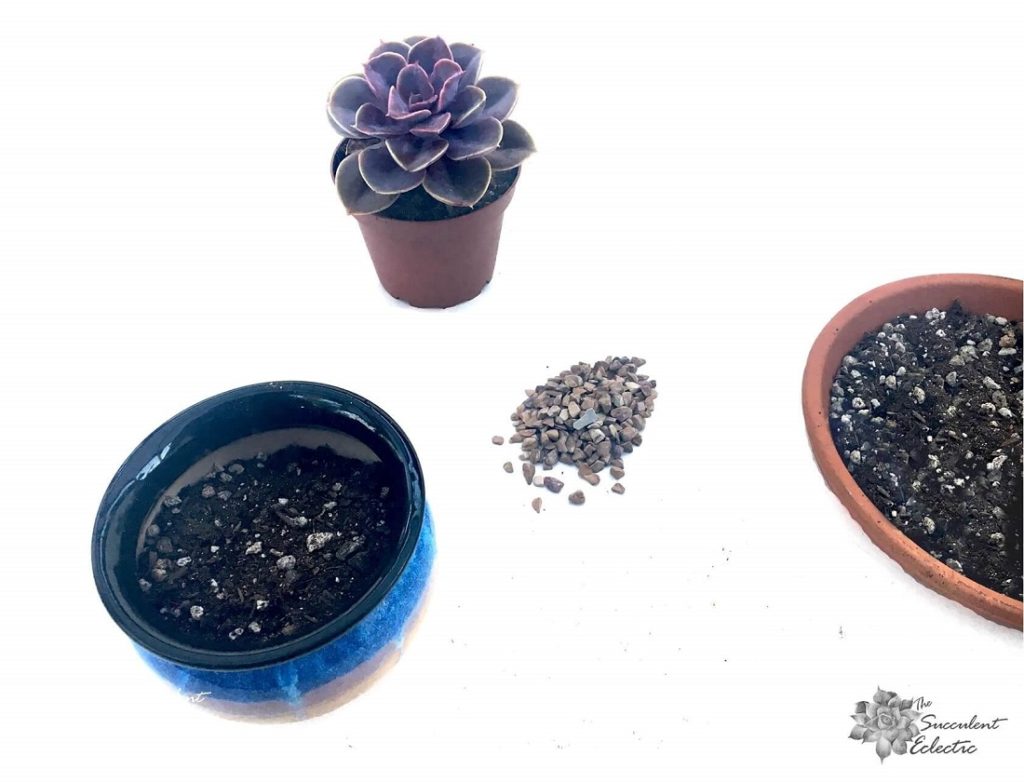
Always, always, always use a good succulent soil when planting succulents. This is the single most important step in succulent care. Succulents are not “regular” plants. Regular potting soil retains too much water, holding it against the roots and leading to root rot and dead plants.
Fill your container about halfway with the succulent soil.
Remove Succulent’s Nursery Pot
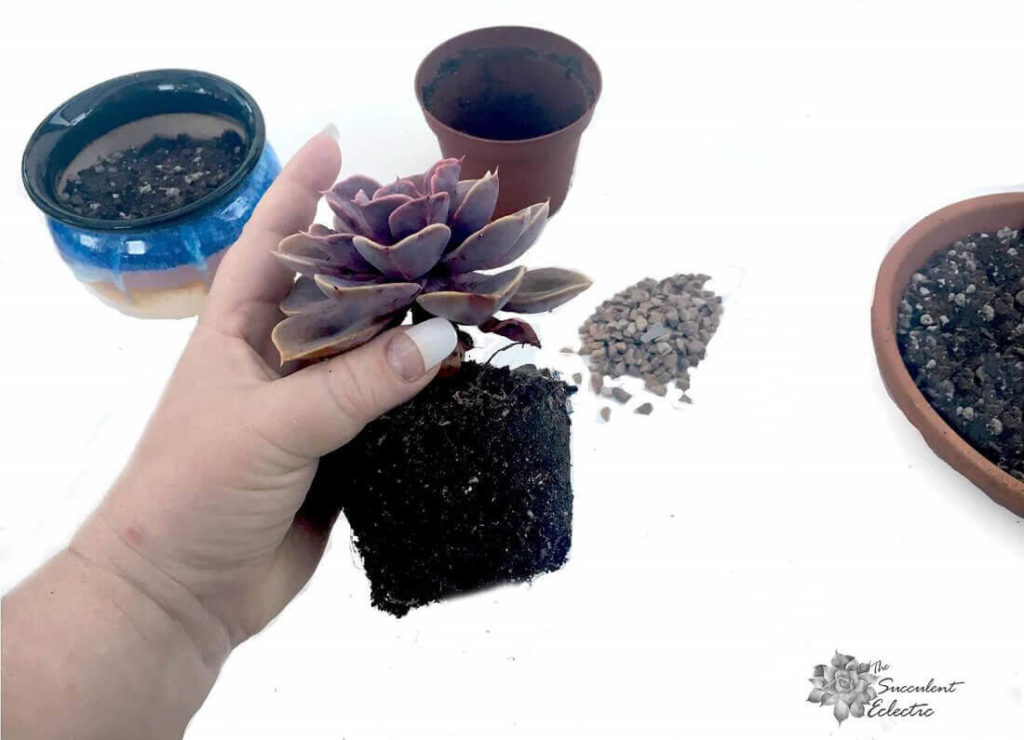
When you remove your succulent from the pot the nursery grew it in, it almost always comes out packed hard, holding the shape of the pot, like this. That’s a good indication that the soil should be largely replaced. Very often, the soil a succulent is growing in is not good soil for the long-term health of the plant.
Gently break up the packed soil and massage the roots, so they are ready to grow in the larger pot. Excess soil will drop away. It will look something like this:
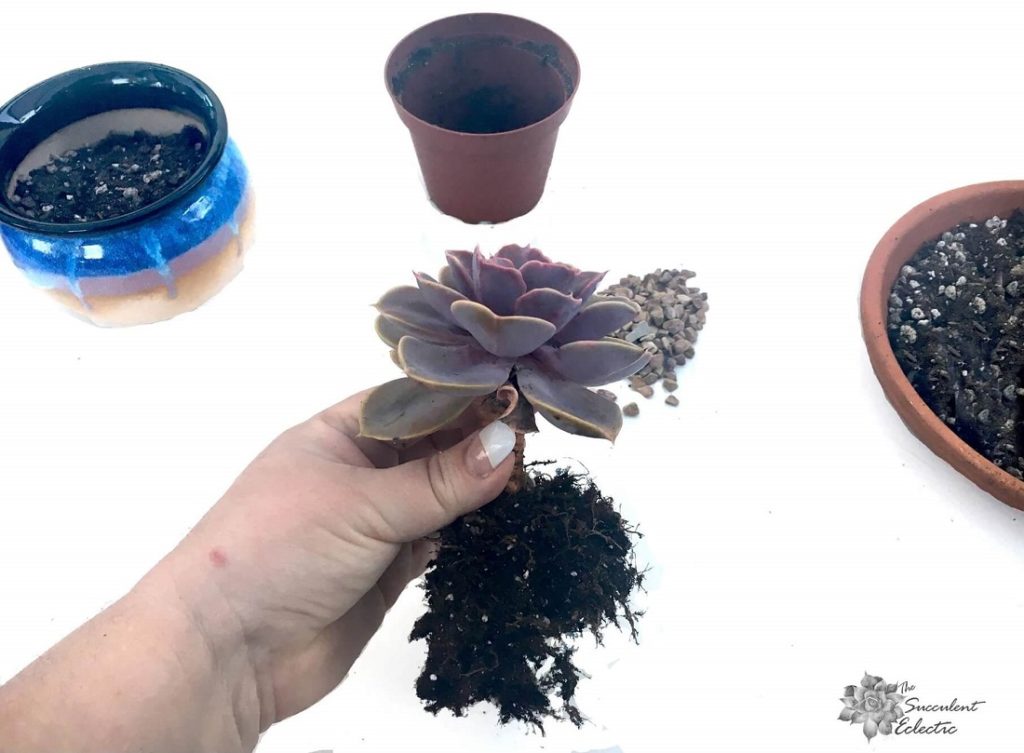
Remove as much of the soil as you can, easily, without breaking up a lot of the roots. Some may break, and that’s ok. Just take care not to tear or break a lot of the root ball. If the soil feels slimy or has a bad odor, wash the soil from the roots and discard it. (This doesn’t often happen.)
See the dried leaf just above my thumbnail? This is a good time to “groom” your succulent. Remove any dried or broken leaves.
Plant the Succulent
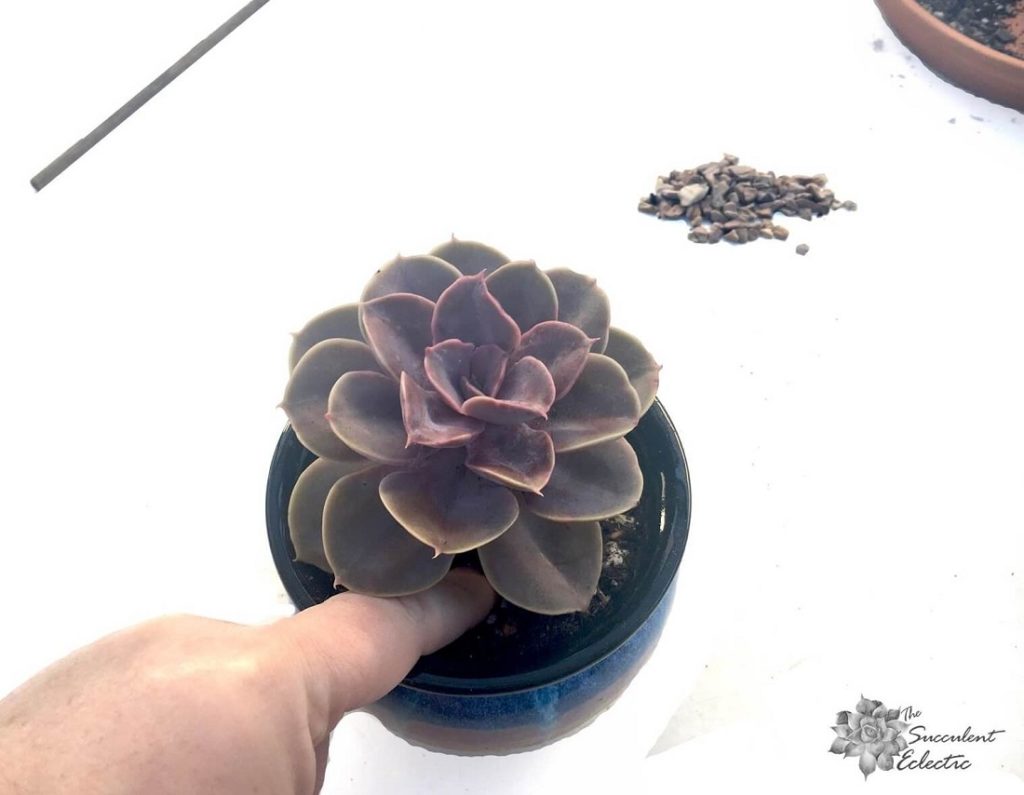
Plant the succulent in the container, spreading the roots out and down. Backfill with fresh succulent soil, and fill to about 1/2 inch below the rim of the pot. Be sure the soil comes up to the soil line on the plant before you removed it from its nursery pot. All roots should be covered, but the lowest leaves should be well clear of the soil.
Next, tamp the soil into place with your finger. You want to collapse any air pockets, and gently firm the soil into place.
Brush Away Stray Soil from Succulent Leaves
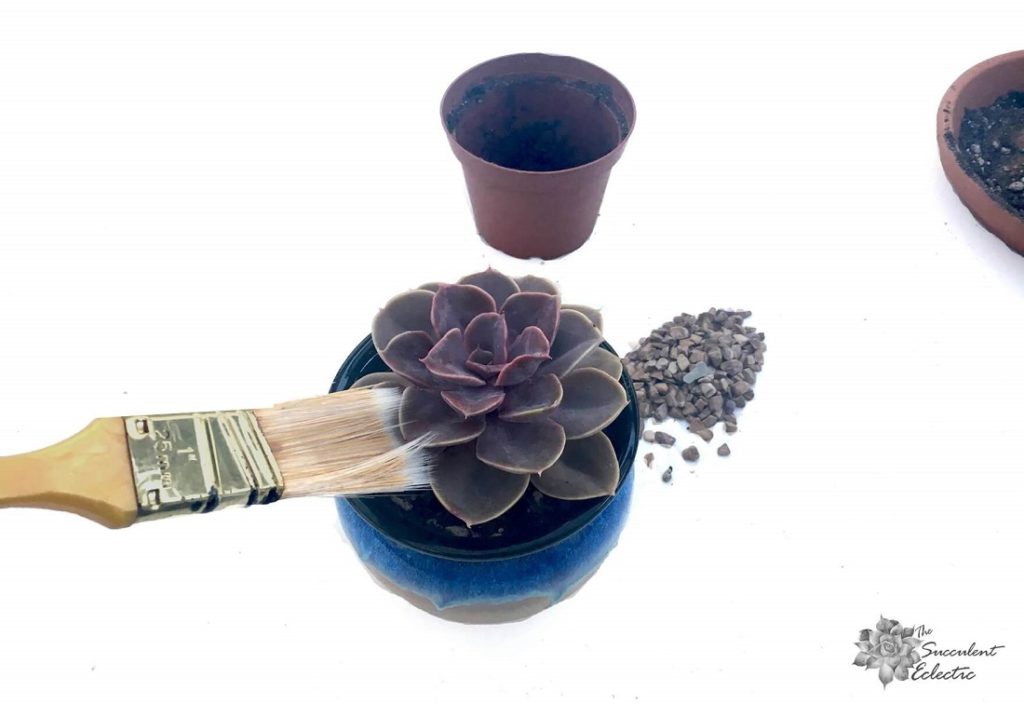
After planting your succulent, use a soft-bristled brush to whisk away any stray soil particles on or between the succulent’s leaves. I always keep a soft paintbrush handy for cleaning my succulents. You don’t want to wipe the leaves with a paper towel or your finger, because this will remove the protective coating some succulents have. (This coating is called epicuticular wax.) The result is unattractive and it interferes with the plant’s natural protection.
Congratulations! You have now planted your succulent! But we’re not quite finished yet…
Adding Top Dressing to Succulent Pot
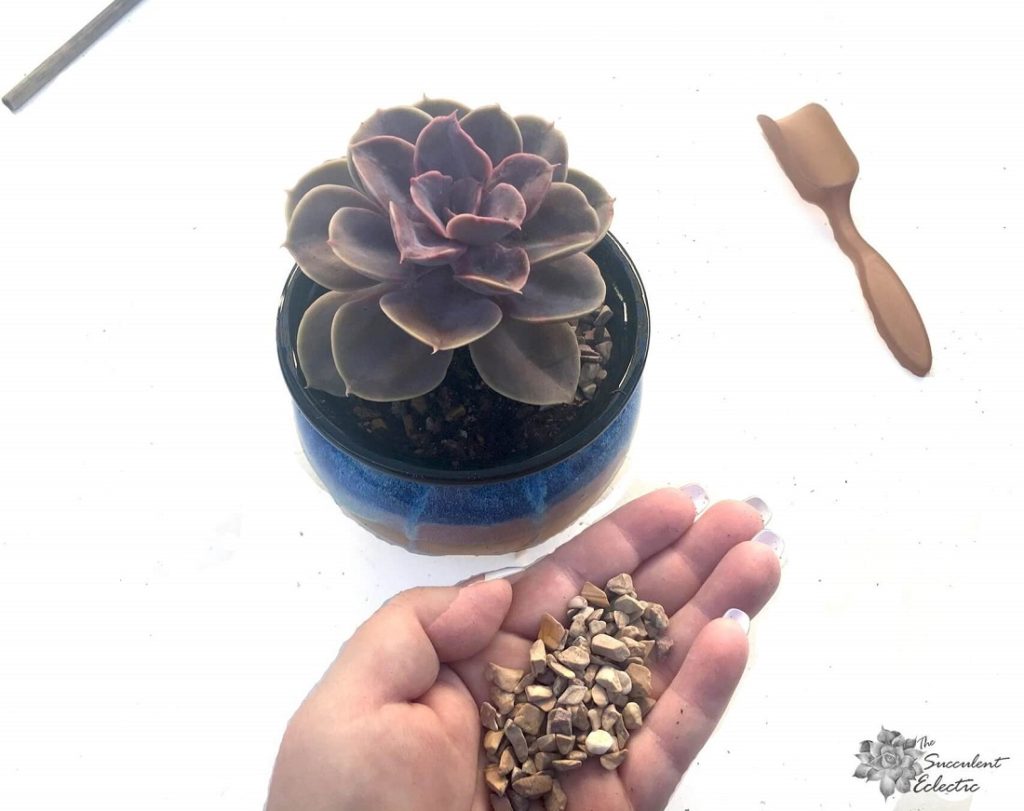
Top dressing for succulents is any inorganic matter you use to cover the soil. When you use decorative pebbles, crushed granite, crushed glass or crushed seashells over the soil, it provides a few important benefits. It helps to regulate the temperature of the soil, insulating the roots from large temperature fluctuations. Top dressing keeps the underside of the leaves clean of soil that can splash up when you water. It prevents insects from laying their eggs in the soil of the plant. Inorganic top dressing is the most reliable way to rid your home of pesky gnats. And — let’s face it — the top dressing looks prettier than the soil. Consider the color and look of your container and succulent. Choose a top dressing to complement both and tie the look together.
Apply the top dressing in a layer about 1/3 of an inch deep, over all of the soil, and right up against the stem of the plant. Use your hands or a small scoop to get the pebbles right where you want them. When you have several plants together, as you’ll see below, that scoop makes it so much easier.
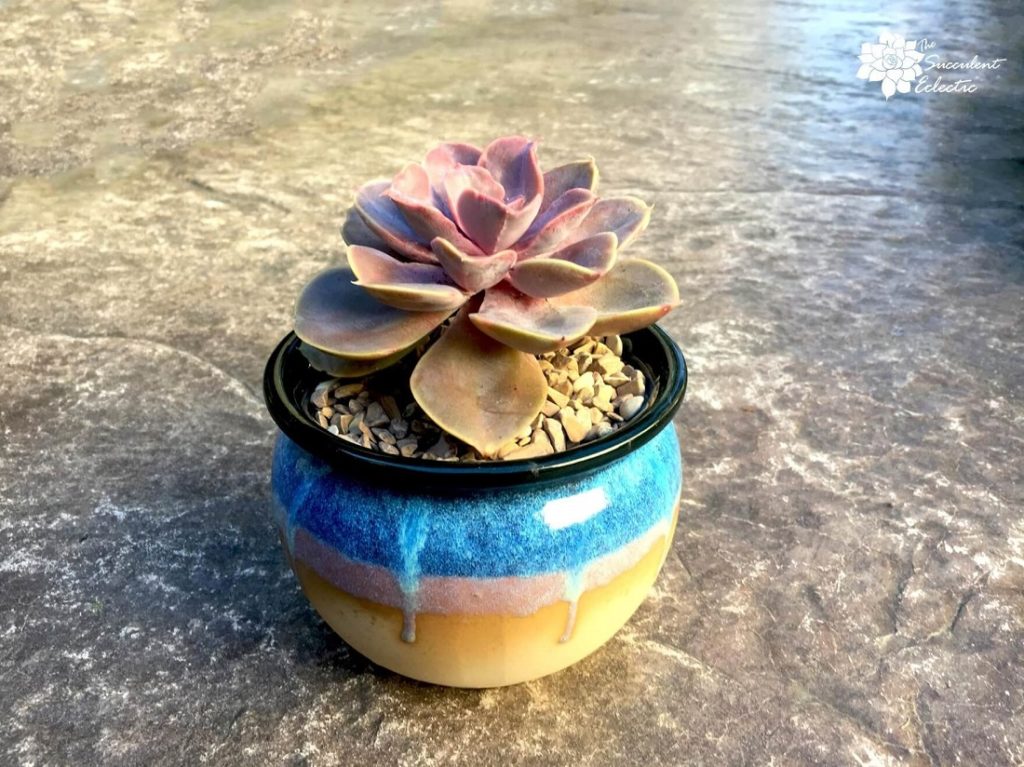
The top dressing gives your planted succulent a finished appearance. Have fun with choosing the top dressing — it’s like jewelry for your plant! Here, I chose a tan crushed gravel that echoes the coloring of the pot.
Let’s see how to plant succulents with several plants in the same container.
How to Plant Succulents Several to a Pot
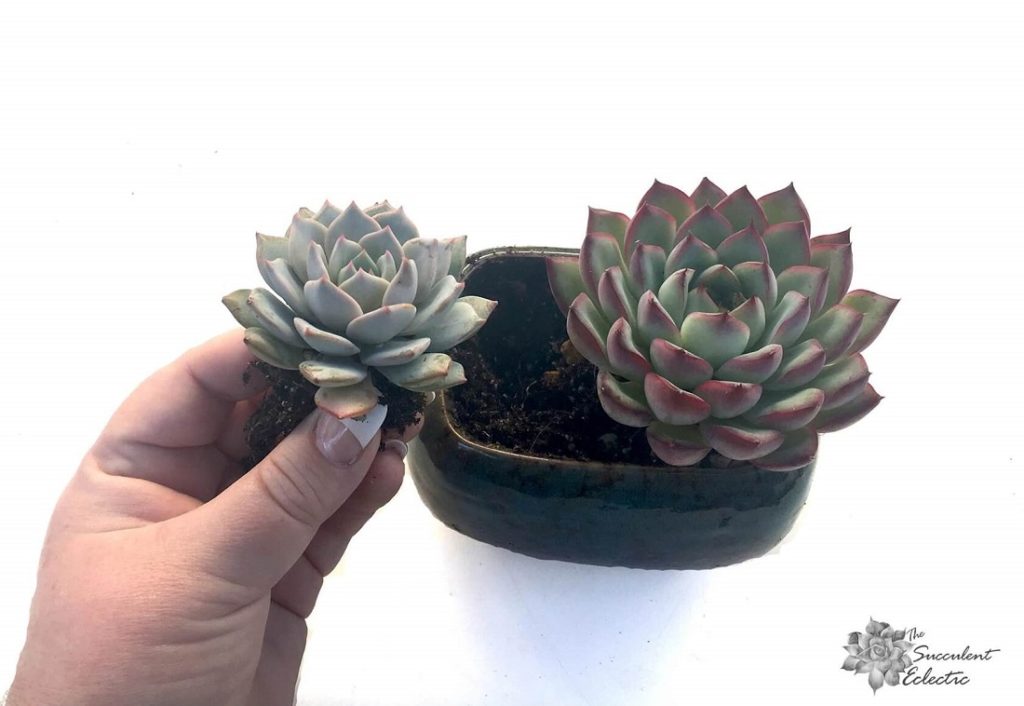
When planting several succulents in a single container, the considerations of the container, drainage and succulent soil are exactly the same. Removing excess soil from the roots allows you to plant succulents closer together.
How close can you plant your succulents? Due to the many adaptations succulents have made to grow in harsh conditions, the plants will thrive when crowded far closer than most plants can tolerate. If you want your succulents to grow larger, give them more room in their container.
Chopsticks are Handy Tools
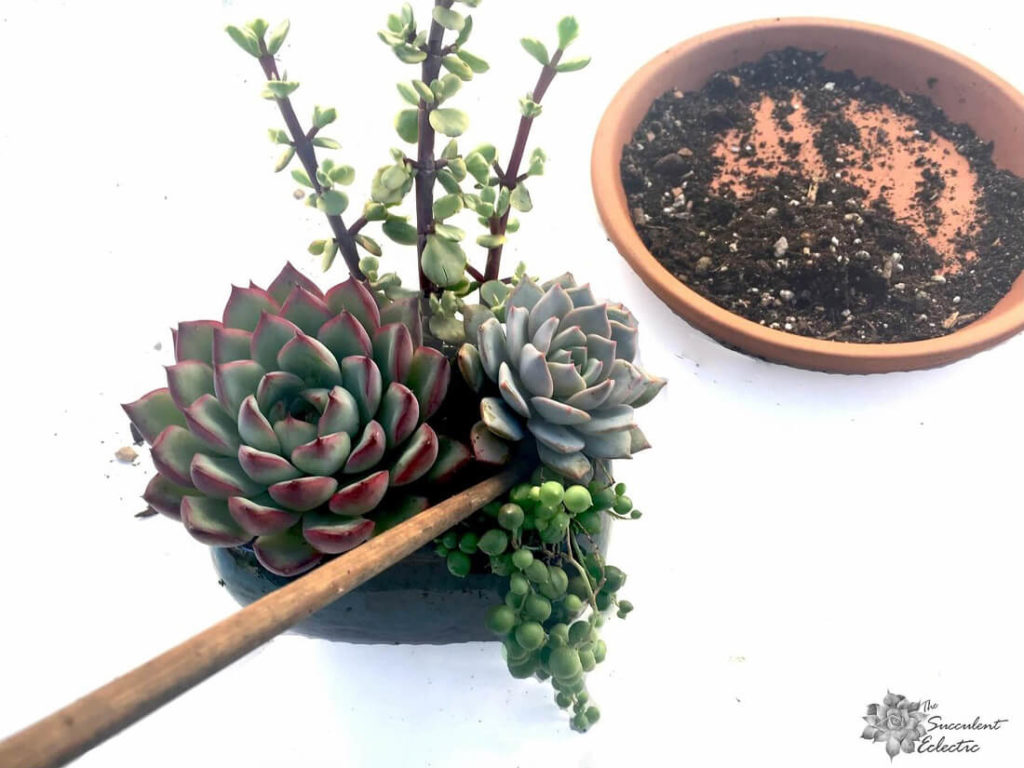
Always be sure to fully tuck the roots under the soil. In tight quarters like this, I use a chopstick to help move the roots into place and to tamp down the soil
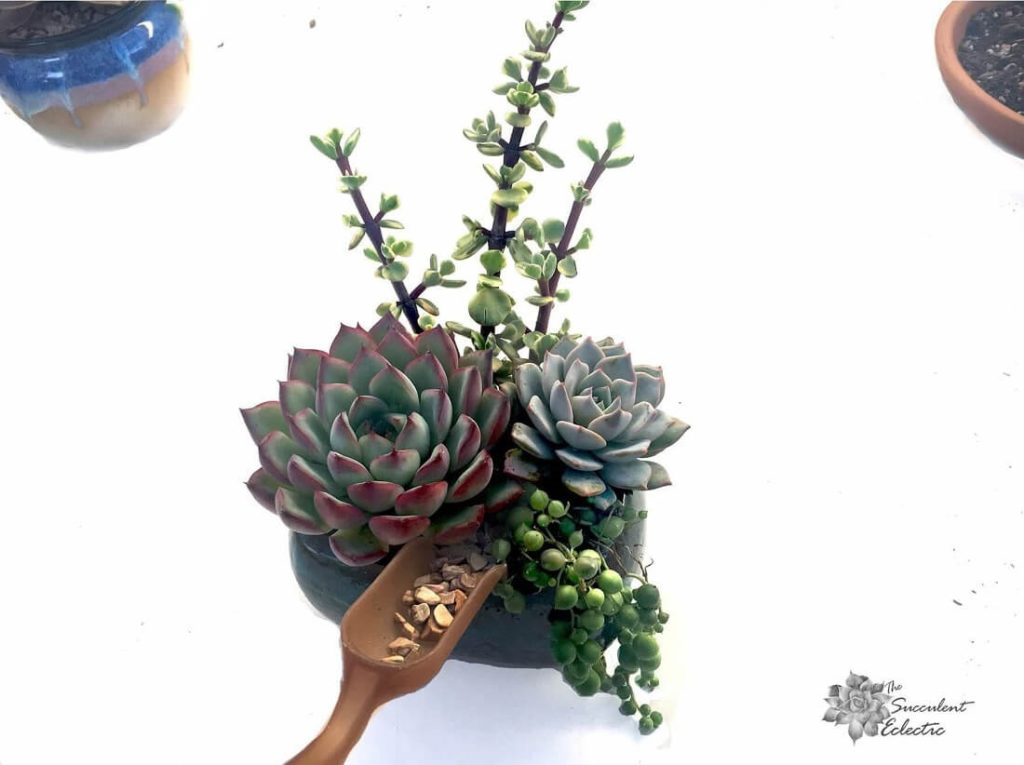
Add top dressing, using the scoop found in succulent tool kits. Cover all exposed soil.
In this 4.8″ x 3″ pot, (from left to right) I planted a 4-inch Echeveria Violet Queen a 2-inch Echeveria colorata, a division of Portulacaria afra variegata (the tall plant in the back) and a division of Senecio rowleyanus ‘String of Pearls’.
How to Water Newly Planted Succulents

Now that you’ve planted your succulents, when is it time to water? I like to give my succulents a couple of days in their new pots before I water them. This is another departure from “normal” plant care. A couple of days gives any bruised, broken or injured roots some time to heal before adding water.
In tightly planted succulent pots, I use this squeeze bottle with a long, narrow spout. It lets me get the water between plants, right at the soil line, where I want it. I am not a fan of watering succulents from overhead, where the water splashes into the succulent’s leaves. Often, it’s fine. But allowing water to collect on the leaves and in the crown of the plant — where many leaves come together — can cause problems. Insects may lay their eggs in this stagnant water, it can lead to rot and it will cause some succulents to quickly collapse (I’m looking at you, E. Black Prince!)
Succulent Planting FAQs
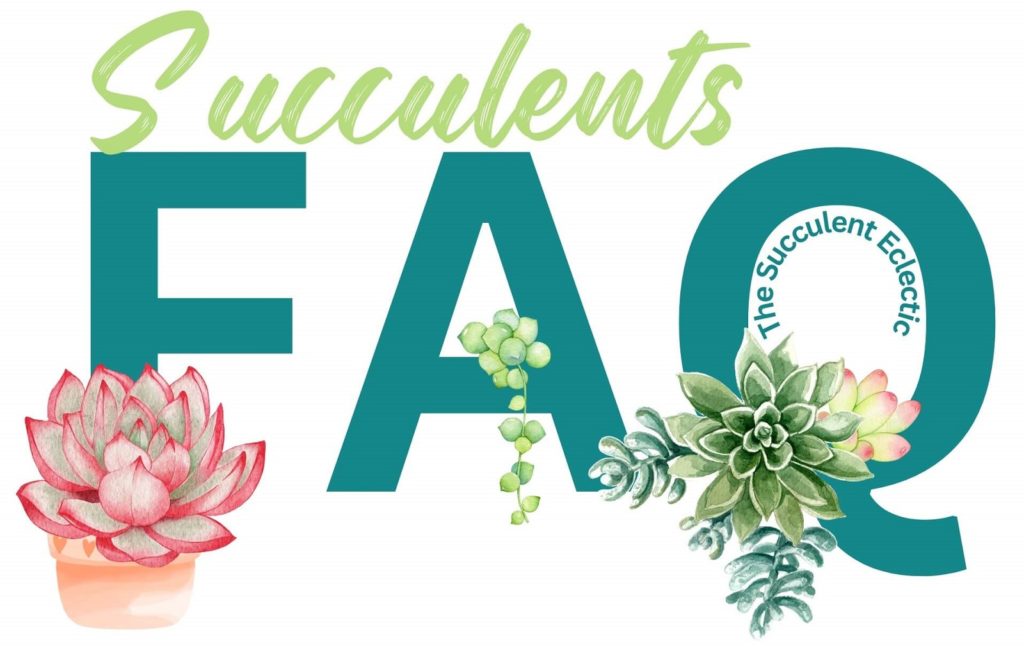
How to plant succulents in pots without drainage holes?
Planting succulents in containers without drainage holes is the same process as if the pot contains holes. Watering, however, is quite different. To avoid overwatering, it is essential to carefully measure the water you provide. It should be no more than 1/3 the volume of the pot. Water only when the soil is dry.
Can you plant succulents in rocks?
Succulents should be planted in fast-draining succulent soil for best results. However, a layer of small rocks added on top of the soil, known as a top dressing, offers a number of benefits for the plant’s health and hygiene.
How to plant bare root succulents?
Bare root succulents are shipped without soil around the roots. Simply tease the roots apart, and spread them out over the soil in the pot, reaching out and down. Cover them well with succulent soil, and tamp down the soil around the plant.
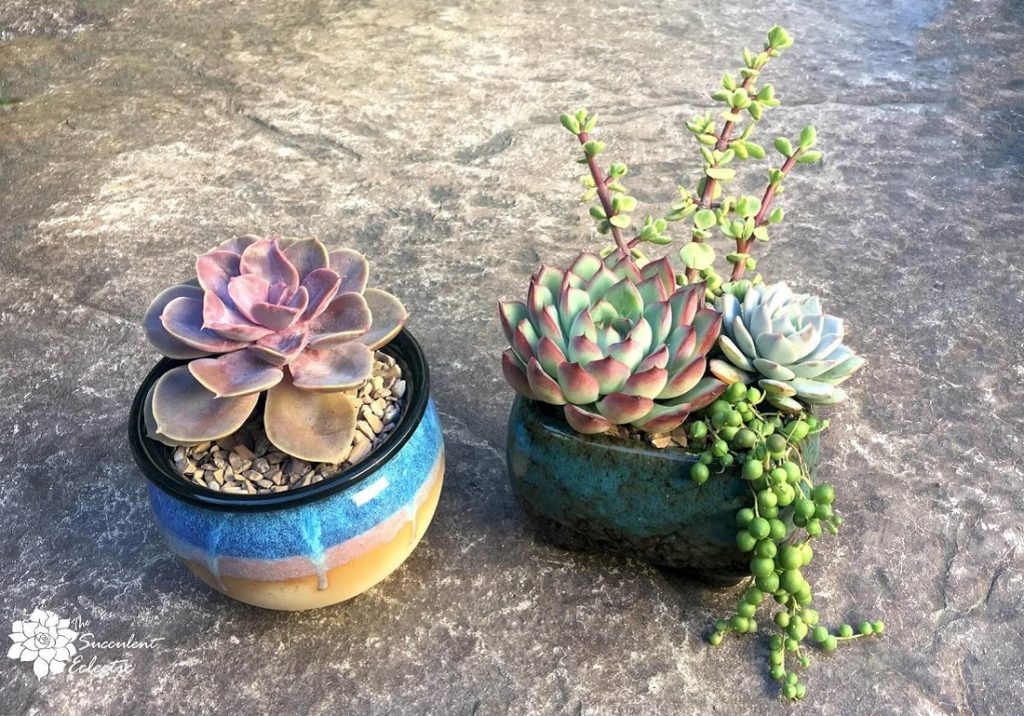
Now that you know how to plant succulents so they’ll thrive, I hope you’ll do just that! Go out and plant lots of succulents, and have fun! Play with combinations of succulent pots, plant(s) and top dressing.
If you have any questions, please take a moment to leave a comment. I will get right back to you!
Because life is just better with succulents!

P.S. For more succulent care information, please subscribe! I’ll send you my FREE e-course, 7 Steps to Succulent Success! Thank you!
P.P.S. Why not join my Facebook Group for succulent-lovers? We talk succulent care, propagation, succulent identification and design. It’s a warm and welcoming group that would love to meet you!
